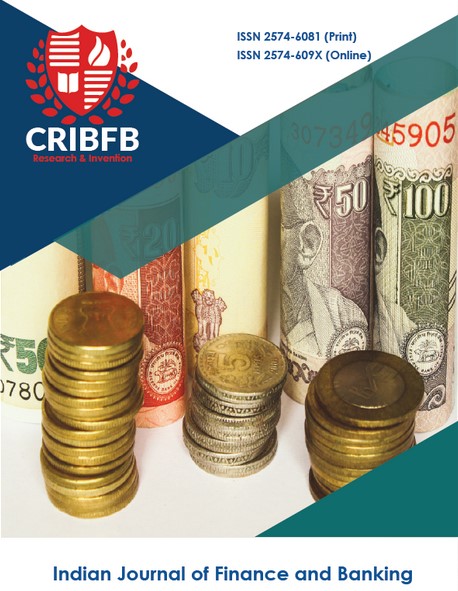SOLVENCY AND SURVIVAL OF MICROFINANCE INSTITUTIONS: AN INDIAN SCENARIO-POLICY IMPLICATIONS TO IMPROVE ENDURANCE
Main Article Content
Abstract
In India, more than 450 million people are outside banking orbit. Many economically deprived communities borrow money from money lenders who charged them to an extent of 115% interest. Microfinance was a strong tool to rescue the poor from Ponzi Schemes. Microfinance industry thrived well in India. It recorded huge growth in South India than North India. The Microfinance crisis broke during the year 2010 in Andhra Pradesh. A bill enacted in Andhra Pradesh made the situation still worse. The repayment rate of the Micro finance clients dropped from 95% (2010) to 1% (2012). This made the survival of the Microfinance Institutions (MFIs) questionable. The paper aims at exploring the solvency and survival positions of the Private & Public NBFC MFIs. Based on the Altman’s Z revised score model (applicable for financial institutions) and Survival analysis, the results reflect that Private NBFC MFIs are solvent and had better survival than Public NBFC MFIs. It aims at understanding the factors discriminating the solvent and insolvent Microfinance Institutions.
JEL Classification Codes: G20, G21, G23, G28, G33.
Downloads
Article Details
Section
How to Cite
References
Ashta, A., Khan, S., & Otto, P. (2015). Does Microfinance Cause or Reduce Suicides? Policy Recommendations for Reducing Borrower Stress. Strategic Change, 24(2), 165-190.
Anjum, S. (2012). Business Bankruptcy prediction model: A significant study of Altman’s Z score. Business Bankruptcy prediction model: A significant study of Altman’s Z Score - Asian Journal of management research, 3(1), 212-219.
Basu, P., & Srivastava, P. (2005). Scaling-up Microfinance for India’s Rural Poor, World Bank Policy Research Working Paper – 3646, 1-32.
Chakravarty, S., & Pylypiv, M. I. (2015). The role of subsidization and organizational status on microfinance borrower repayment rates. World Development, 66, 737-748.
Chandrasekhar, C.P. & Ghosh, J. (2012). Whatever happened to microfinance?. Retrieved from http://www.thehindubusinessline. com/ opinion/ columns/c-p-chandrasekhar/whatever-happened-to-microfinance/ article 3907679.ece
Cull, R., Demirgüç-Kunt, A., & Morduch, J. (2011). Does regulatory supervision curtail microfinance profitability and outreach?. World Development, 39(6), 949-965.
Janardhanan, A. K., & Uma, V. R. (2020). The role of internal control and firm-specific characteristics on firm value: Evidence from Indian financial services sector. Indian Journal of Finance and Banking, 4(1), 117-133.
Jayasheela, D. P., & Hans, V. B. (2006). Financial Inclusion and Micro-Finance in India: An Overview. Electronic copy available at: http://ssrn. com/abstract, 1089680
Krishna Chaitanya, V. (2005). Measuring Financial Distress of IDBI Using Altman Z-Score Model. The ICFAI Journal of Bank Management, August, 4(3), 7-17.
Kundu, A. (2009). Choice between Microfinance Systems Operating on the Basis of Individual Liability Loan Contract or through Joint Liability Loan', Microfinance Review, 1(1), 14-31.
Khaddafi, M., Falahuddin, F., Heikal, M., & Nandari, A. (2017). Analysis Z-score to predict bankruptcy in banks listed in Indonesia stock exchange. International Journal of Economics and Financial Issues, 7(3), 326.
Kaur, P. (2016). Efficiency of microfinance institutions in India: are they reaching the poorest of the poor?. Vision: The Journal of Business Perspective, 20(1), 54-65.
Marulanda, B., Fajury, L., Paredes, M., & Gomez, F. (2010). Taking the good from the bad in microfinance: lessons learned from failed experiences in Latin America. San Jose, Costa Rica: Calmeadow Foundation.
Opinya, J. N., & Kwasira, J. (2015). An Assessment of the Survival Strategies Adopted by Microfinance Institutions in Nakuru Town, Kenya, International Journal Of Innovative Research & Development, 4(5), 99-104. Retrieved from http://52.172.159.94/index.php/ijird/article/viewFile/70544/55193
Rahman, S. M. K., Islam, M. K., & Hossain, M. M. (2021). Leverage induced financial distress of manufacturing firms in Bangladesh: a comparison between listed MNCs and domestic firms by applying Altman’s Z score model. Indian Journal of Finance and Banking, 5(2), 28-43. https://doi.org/10.46281/ijfb.v5i2.1006
Roy, S. (2011). Microfinance in India: An Overview of Microfinance and SWOT Analysis of Microfinance (January 25, 2011). http://dx.doi.org/10.2139/ssrn.1747874
Schulte, M., & Winkler, A. (2019). Drivers of solvency risk–Are microfinance institutions different?. Journal of Banking & Finance, 106, 403-426.
Sharma, N. (2013). Altman model and financial soundness of Indian banks. International Journal of Accounting and Finance, 3(2), 55-60.
Samer, S., Majid, I., Rizal, S., Muhamad, M. R., & Rashid, N. (2015). The impact of microfinance on poverty reduction: Empirical evidence from Malaysian perspective. Procedia - Social and Behavioral Sciences, 195, 721–728. https://doi.org/10.1016/j.sbspro.2015.06.343
Sangwan, S., & Nayak, N. C. (2020). Outreaching the poor under microfinance institutions in India: Rhetoric versus realities. Journal of Public Affairs, 20(4), e2161.
Sahai, S., Sinha Ray, R., & Tapasvi, S. K. (2020). Why Private Sector Led Financial Inclusion Cannot Work for Development? Case of Micro Credit in India. Indian Journal of Finance and Banking, 4(1), 14-19. https://doi.org/10.46281/ijfb.v4i1.482
Thorat, Y. S. P. (2006). Microfinance in India; Sectoral issues and challenges. Towards a sustainable microfinance outreach in India, 27-42.
Tanwar, J., Seth, H., Vaish, A. K., & Rao, N. V. M. (2020). Revisiting the Efficiency of Indian Banking Sector: An Analysis of Comparative Models Through Data Envelopment Analysis. Indian Journal of Finance and Banking, 4(1), 92-108. https://doi.org/10.46281/ijfb.v4i1.585
Youssef, A. B. (2018). Migration Analysis of Credit Risk in Tunisian Banking Sector. Indian Journal of Finance and Banking, 2(1), 34-43. https://doi.org/10.46281/ijfb.v2i1.91




